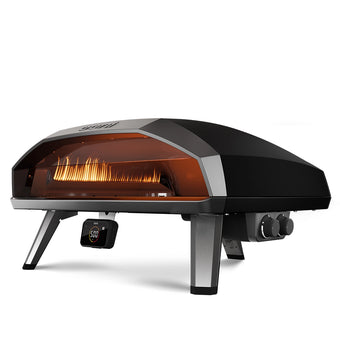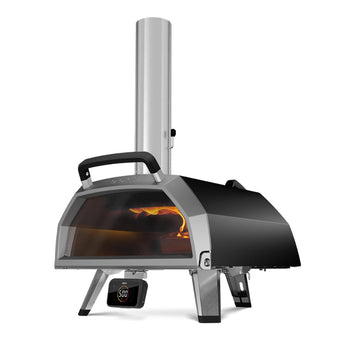Without yeast, our pizzas wouldn’t rise and we wouldn’t be able to enjoy corniciones (the delicious puffy pizza crusts we all love), sourdough, rolls, sandwich loaves and other kinds of bread. Yeast does a whole lot for humans; besides helping us bake bread, it’s also an integral part of brewing alcohol. But what exactly is it, and where does it come from?
Fantastic Fungi
Yeast is a single-cell organism from the fungi kingdom, and there are about 1,500 species that have been identified. They work by feeding on sugars and converting that into carbon dioxide, and with more time, alcohol. According to Merriam-Webster, the word comes from the Old High German jesen, gesen–to ferment–and Greek zein–to boil–which makes sense, given the bubbles that appear in bread and beer during fermentation.
All three of the main types of yeast used in pizza making have some amount of water removed to keep them in a dormant state; the lower the moisture content, the longer the yeast lasts. It is a living, single cell organism that is activated by moisture and heat. For activating yeast, San Francisco-based pizzaiolo and owner of Tony’s Pizza Napoletana, Tony Gemignani, recommends warm water (never hot) and never more than 30 °C (85 °F); he usually does 27 °C (80 °F).
Leaven…what’s that?
A leaven is any substance that causes your dough to ferment and expand. Yeast, sourdough, baking powder… all leavens. You can also refer to the act of leavening as the process involved in rising. Leavening is just the act of gas and air being released by the ‘leavening agent’ causing your dough to rise and take on an airy, puffy nature.
Is my yeast (still) alive?
We’ve all found that packet of Ye Olde Ancient Yeast from 1982 at the back of the cupboard, and wondered “Will this be ok?”. As a quick test, get a cup of lukewarm water, sprinkle in some yeast and some sugar, and stir it up. If it dissolves and you get bubbles, your yeast is good to go! Still sat there? May it rest in yeast!
Active Dried Yeast (ADY)
Active dried yeast is live yeast that is dehydrated. This type is sold in small pre-portioned packets, or slightly larger tins. Although dormant cells, you do need to store with caution. Keep them at room temperature or below, as the yeast will expire if exposed to high temperatures. Once open, you can store in the freezer (provided it's stored in an airtight container) for several months. Although the name ‘active’ might lead you to believe that it’s ready to go, you do need to activate active dry yeast in lukewarm water to check its activity. This process is called ‘blooming’ and the yeast and water mixture should foam in a few minutes. If the water is lifeless, we’re afraid so is your yeast, and you’ll struggle to get a rise from it. Active dry yeast is great for longer proofing times due to its fermentation process, providing a slightly deeper flavour to the trained palate.

Instant Dried Yeast (IDY)
Instant yeast is more consistent than its Active friend, is more potent, and can be stored in the same way. The granules are smaller and you’ll find that it provides a rapid rise. Unlike active dry yeast, you don’t need to dissolve in water before adding to flour, but many people prefer to. Instant yeast is very convenient as it generally needs a shorter ferment, plus you use around 25% less than active dry yeast.
Fresh Yeast
Fresh yeast is harder to come by in supermarkets, it must be refrigerated and is sold in small cubes consisting of water and yeast. It feels a little like blu-tac, but is crumbly.
It’s super important to store fresh yeast carefully. If mould appears on the yeast, do not use it as it’s not safe to do so. Ensure your fresh yeast is stored in an airtight container in the fridge. Generally it lasts for around a week or two. It can also be frozen, but you need to wrap it tightly in plastic wrap before doing so.
Fresh yeast is much stronger in flavour and is preferred by bakers for sweeter recipes. We recommend using around 70% more fresh yeast versus instant yeast, or around 60% more than active dry yeast.
Nutritional Yeast
Nutritional yeast comes up a lot in vegan cooking, but all it’s good for is flavour. This is because of the way it’s processed. The high heat kills the live cultures, rendering the yeasts unable to feed on sugars and create the all-important carbon dioxide, so don’t use this expecting a rise. However, nutritional yeast is great as a vegan substitute for cheese and flavour: mix it with breadcrumbs and toss over a marinara pizza for a Sfincione (a soft, fluffy Scilian-style pizza) effect, or sprinkle over a prebaked crust for a vegan umami boost of flavour.

Preferments
Popular in bread making, preferments are a type of dough starter made with a combination of flour, water, and either yeast or a sourdough starter. After mixing, the preferment is left to sit for several hours before it is mixed into the bread dough. Four common preferments include:
- Sourdough starter, a homemade yeast made from fermented flour and water. A mix of bacteria from a number of sources, and yeast from the flour marry to create a home-made solution to leavening bread and other baked goods. Items baked using sourdough as the natural levain produce easy-to-digest, flavoursome products. Sourdough tends to rise slower than commercial yeast products, so you may have to wait longer.
- Poolish, which might sound complex, but it’s actually incredibly simple. It was introduced by Polish bakers and is essentially a pre-ferment. It’s similar to a sourdough starter, but you don’t have to spend days nurturing, feeding, and praying it doesn’t die. All it takes is a small amount of yeast (dry or fresh), and equal parts flour and water, making it 100% hydration. Mix together and leave for around 24 hours, before adding to your dough the next day.
- Biga, is often talked about alongside poolish and that’s because they are very similar. Again, small amount of yeast, flour and water, then left to pre-ferment before adding to pizza dough. However, Biga is slightly drier at around 50-60% hydration than Poolish making it easier to handle manually.
- Tiga, which was invented by “The Pizza Bible” author and 12-time World Pizza Champ, Tony Gemignani. It’s like a Biga, but with a higher hydration at around 70%, making it trickier to handle.
There isn't necessarily a right or wrong yeast, just different pizza styles and taste preferences. You’ll have dough fans who vehemently argue that biga is better, whilst fresh yeast is commonly used in Napoli. Ultimately, keep experimenting along your pizza journey, and if you want extra guidance, we have a handy dough calculator app that takes every variable into consideration, including temperature, hydration, dough ball size, proofing time, and, of course, type of yeast!










